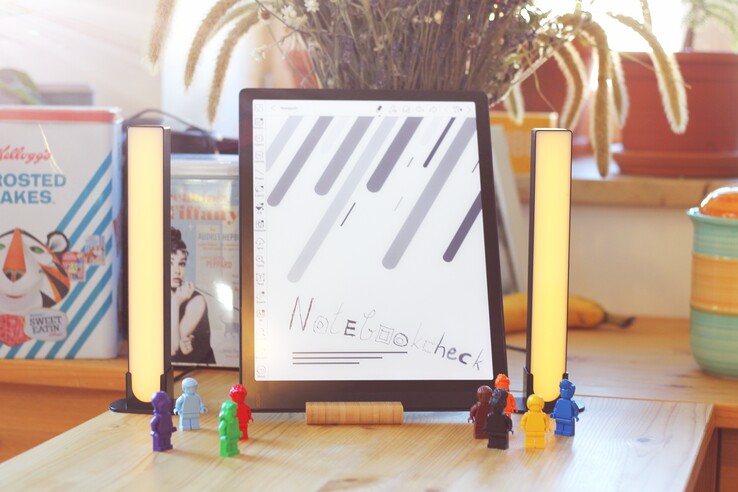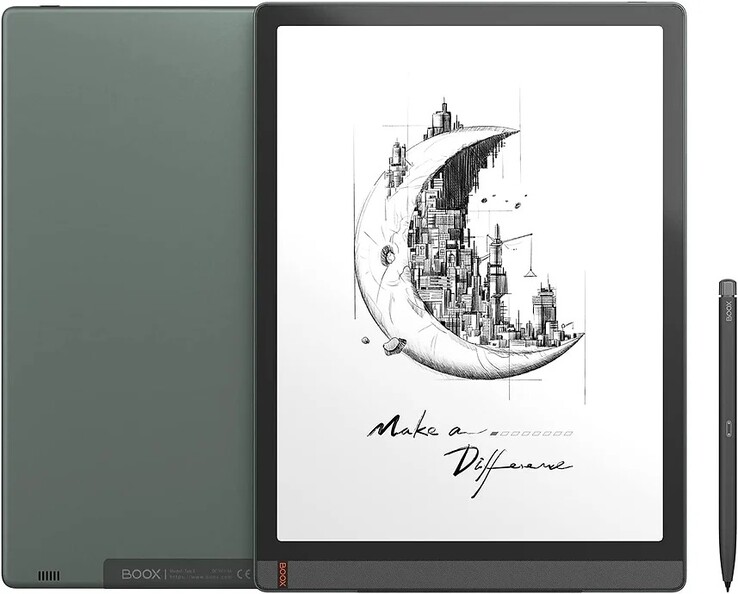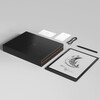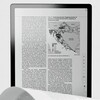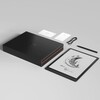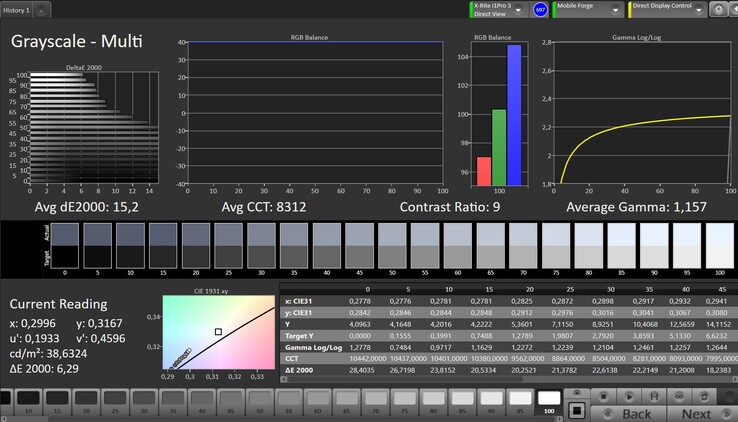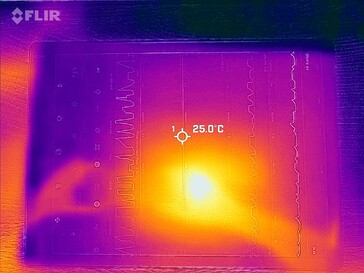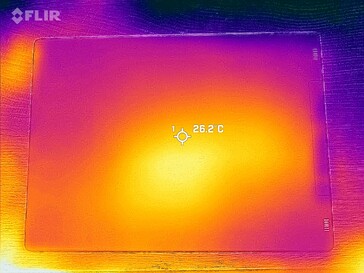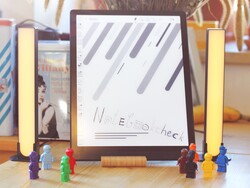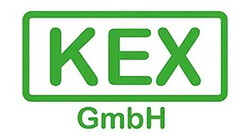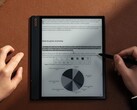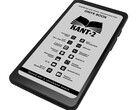Onyx Boox Tab X review - E-Ink tablet for big tasks?
Possible competitors in comparison
Rating | Date | Model | Weight | Drive | Size | Resolution | Price |
|---|---|---|---|---|---|---|---|
| 78.5 % v7 (old) | 02 / 2024 | Onyx Boox TabX SD 662, Adreno 610 | 570 g | 128 GB UFS 2.1 Flash | 13.30" | 2200x1650 | |
| 82.2 % v7 (old) | 12 / 2023 | Onyx Boox Tab Ultra C Pro SD 855, Adreno 640 | 450 g | 128 GB UFS 3.1 Flash | 10.30" | 1240x930 | |
| 75.2 % v7 (old) | 08 / 2023 | Lenovo Smart Paper RK3566, Mali-G52 MP2 | 408 g | 64 GB eMMC Flash | 10.30" | 1872x1404 | |
| 79.4 % v7 (old) | 08 / 2022 | Huawei MatePad Paper Kirin 820e, Mali-G57 MP6 | 360 g | 64 GB UFS 2.2 Flash | 10.30" | 1872x1404 |
Case and equipment - Metal chassis looks fragile
If you are looking for a really large e-ink tablet with pen input, you should take a look at the Onyx Boox Tab X: With its 13.3-inch screen, it is one of the largest e-readers on the market. At 950 euros, the device is not exactly cheap, but there is hardly any other tablet that offers so much space for reading and taking notes.
The housing is made of an aluminum-magnesium material and weighs 570 grams. This is actually fine considering the size of the tablet, but it is still noticeably heavier than handier e-readers. The edges around the screen are just over a centimeter wide, only the bottom is 2.5 centimeters wide so that you can hold the Tab X comfortably without constantly accidentally operating the touchscreen.
With such a huge tablet, there is of course always the question of stability: The Onyx Boox Tab X can be twisted and then creaks noticeably; our test even revealed a hairline crack on the side. The tablet should therefore be handled with care. There is no IP certification for the chassis, so you should also refrain from submerging it in the bathtub or using it in dusty environments.
With 128 GB of mass storage and 6 GB of RAM, the memory configuration is adequate. However, the UFS 2.1 flash installed here could be faster in this price range.
External devices can be connected via a USB-C port and Bluetooth. However, there is no microSD port for memory expansion.
Communication, software and operation - Android apps for more flexibility
WiFi 5 is the fastest Wi-Fi standard that the Tab X can use. It therefore achieves reasonable speeds and quite stable transmission. However, a gigabit Internet connection cannot really be utilized. This is a shame, especially considering the high price level. The Huawei MatePad Paper or the Onyx Boox Tab Ultra C Pro show how it can be done better.
You have to do without mobile internet, as there is no SIM slot. The tablet can determine an approximate position even without satellite support via Google's Wi-Fi database, but this is rather inaccurate when moving and in areas with few Wi-Fi networks.
The operating system used is Android 11, which has a less modified interface than other e-readers: You can find widgets and icons on the home screen and place additional apps on new pages. Everything can be moved or combined into groups. The security patches date from June 2023 and are therefore over six months old at the time of testing. The manufacturer does not specify how often new updates will be available.
The touchscreen works reliably, but the low frame rate of the e-ink display means you have to get used to slight delays in the system's response. The stylus can be used to take notes and draw, although only the 16 shades of gray on the screen are available. Of course, you can also use creativity apps from the Google Play Store.
What strikes us: The large e-ink tablet has hardly any physical buttons. There is only the standby button on the top edge but no scroll buttons or volume control. You therefore have to control these things via the touchscreen.
A password can be set for data security. However, the device cannot be unlocked biometrically, for example using fingerprints.
| Networking | |
| iperf3 transmit AXE11000 | |
| Huawei MatePad Paper | |
| Onyx Boox Tab Ultra C Pro | |
| Onyx Boox TabX | |
| Lenovo Smart Paper | |
| iperf3 receive AXE11000 | |
| Huawei MatePad Paper | |
| Onyx Boox Tab Ultra C Pro | |
| Onyx Boox TabX | |
| Lenovo Smart Paper | |
E-reading - Many possibilities
The pre-installed Neo Reader is very versatile and can also be used in split-screen mode with other apps, for example, to take notes. You can activate automatic page turning after a set time or have texts read aloud using text-to-speech. In terms of voice quality, this is of course more of a makeshift solution than a real audio book, but at least it works.
A big advantage of the Android system is that you can also download other reader apps such as Tolino or Amazon Kindle, and use them without any problems.
Display - Black and white display with high contrast
The E-Ink display comes from the Mobius series and has a resolution of 2,200 x 1,650 pixels. This type of screen works completely differently than IPS, OLED, or MiniLED displays: here, tiny ink particles with different electrical charges are actually physically present and positioned. This results in great contrast and good readability in ambient light without additional lighting.
In this case, it is a black and white panel with 16 shades of gray, which often makes the display appear somewhat coarse for images, but is ideal for drawings and text. The screen has a matt coating so that the tablet can also be used outdoors.
The display is illuminated from the front if required, as the ink particles are not translucent. The maximum brightness is between 55 and 88 cd/m², depending on the area. As the screen light is only required for operation in low ambient brightness, this brightness level is completely sufficient.
There is no PWM flickering, as once an image has been displayed, it does not need to be refreshed with this technology, provided the content does not change. The screen lighting should also be flicker-free thanks to the use of a direct current voltage source, as confirmed by our oscilloscope.
| |||||||||||||||||||||||||
Brightness Distribution: 63 %
Center on Battery: 65 cd/m²
Contrast: ∞:1 (Black: 0 cd/m²)
ΔE Greyscale Calman: 15.2 | ∀{0.09-98 Ø5}
Gamma: 1.157
CCT: 8312 K
| Onyx Boox TabX E-Ink Mobius, 2200x1650, 13.3" | Onyx Boox Tab Ultra C Pro E-Ink, 1240x930, 10.3" | Lenovo Smart Paper E-Ink, 1872x1404, 10.3" | Huawei MatePad Paper E-Ink, 1872x1404, 10.3" | |
|---|---|---|---|---|
| Response Times | 13% | 39% | 9% | |
| Response Time Grey 50% / Grey 80% * (ms) | 144.7 ? | 105.5 ? 27% | 134.4 ? 7% | 121 ? 16% |
| Response Time Black / White * (ms) | 95.9 ? | 98.1 ? -2% | 27.5 ? 71% | 94 ? 2% |
| PWM Frequency (Hz) | ||||
| Screen | 2% | 50% | 13% | |
| Brightness middle (cd/m²) | 65 | 44 -32% | 113 74% | 61.9 -5% |
| Brightness (cd/m²) | 67 | 43 -36% | 106 58% | 60 -10% |
| Brightness Distribution (%) | 63 | 91 44% | 83 32% | 80 27% |
| Black Level * (cd/m²) | ||||
| Greyscale dE 2000 * | 15.2 | 10.5 31% | 9.9 35% | 9.1 40% |
| Gamma | 1.157 190% | 1.202 183% | 1.371 160% | 2.02 109% |
| CCT | 8312 78% | 6629 98% | 7116 91% | 6848 95% |
| Colorchecker dE 2000 * | 19.76 | |||
| Colorchecker dE 2000 max. * | 37.12 | |||
| Total Average (Program / Settings) | 8% /
5% | 45% /
46% | 11% /
12% |
* ... smaller is better
Display Response Times
| ↔ Response Time Black to White | ||
|---|---|---|
| 95.9 ms ... rise ↗ and fall ↘ combined | ↗ 47.1 ms rise | |
| ↘ 48.8 ms fall | ||
| The screen shows slow response rates in our tests and will be unsatisfactory for gamers. In comparison, all tested devices range from 0.1 (minimum) to 240 (maximum) ms. » 100 % of all devices are better. This means that the measured response time is worse than the average of all tested devices (20.3 ms). | ||
| ↔ Response Time 50% Grey to 80% Grey | ||
| 144.7 ms ... rise ↗ and fall ↘ combined | ↗ 67 ms rise | |
| ↘ 77.7 ms fall | ||
| The screen shows slow response rates in our tests and will be unsatisfactory for gamers. In comparison, all tested devices range from 0.165 (minimum) to 636 (maximum) ms. » 100 % of all devices are better. This means that the measured response time is worse than the average of all tested devices (31.7 ms). | ||
Screen Flickering / PWM (Pulse-Width Modulation)
| Screen flickering / PWM not detected | |||
In comparison: 53 % of all tested devices do not use PWM to dim the display. If PWM was detected, an average of 8152 (minimum: 5 - maximum: 343500) Hz was measured. | |||
Performance, emissions and battery life - Only mediocre performance
With the Qualcomm Snapdragon 662 onyx Boox has only opted for a mid-range SoC for its Tab X, despite the high device price, which was also released 5 years ago. Compared to conventional e-readers without app support, the tablet still offers good performance. However, the in-house competition, such as the Tab Ultra C Pro, achieves results that are sometimes twice or even three times as high in the benchmarks.
The Tab X's performance is sufficient for everyday use; if you mainly read books and take notes, you will get a reasonably smooth experience. However, the UFS 2.1 flash used is also relatively slow. When surfing the Internet, you sometimes have to wait longer for websites to load, and images, in particular, take a long time to scroll.
Due to the tablet's large surface area, the SoC has no problem dissipating waste heat. As a result, the casing hardly heats up even after prolonged load: We measured a maximum of 29.2 °C. Even longer load hardly reduces the performance: The SoC delivers similar values in the 3DMark burnout test towards the end as at the beginning.
The speakers are located on the back of the device. Since there are two of them, stereo effects are possible, but they are not very noticeable due to the close placement. The speakers are not particularly loud, and the sound is very treble-heavy. Voices are reproduced clearly but sound less present and not very warm.
External speakers or headphones can be connected via Bluetooth or the USB-C port, which works without any problems and delivers a much better sound.
The battery has a capacity of 6300 mAh. This makes it significantly more powerful than most other e-readers and also gives the Tab X very good runtimes: With minimum screen lighting and in reading mode, the tablet manages 24:46 hours.
The tablet can be charged with up to 10 watts, which leads to very long charging times of up to 5 hours due to the large battery. Furthermore, you have to get a charger since it is not included in the package.
| PCMark for Android - Work 3.0 | |
| Average of class Tablet (3195 - 27428, n=85, last 2 years) | |
| Onyx Boox Tab Ultra C Pro | |
| Average Qualcomm Snapdragon 662 (3195 - 7554, n=6) | |
| Onyx Boox TabX | |
| Lenovo Smart Paper | |
| Onyx Boox TabX | Onyx Boox Tab Ultra C Pro | Lenovo Smart Paper | Huawei MatePad Paper | Average 128 GB UFS 2.1 Flash | Average of class Tablet | |
|---|---|---|---|---|---|---|
| AndroBench 3-5 | 118% | -54% | 65% | 59% | 355% | |
| Sequential Read 256KB (MB/s) | 514.4 | 1487 189% | 163 -68% | 880.1 71% | 761 ? 48% | 1656 ? 222% |
| Sequential Write 256KB (MB/s) | 109.5 | 302.2 176% | 139 27% | 256.2 134% | 296 ? 170% | 1213 ? 1008% |
| Random Read 4KB (MB/s) | 137.8 | 226.8 65% | 25.3 -82% | 145.6 6% | 154 ? 12% | 235 ? 71% |
| Random Write 4KB (MB/s) | 121.7 | 169.9 40% | 8.8 -93% | 183.1 50% | 130.4 ? 7% | 267 ? 119% |
Temperature
(+) The maximum temperature on the upper side is 29.2 °C / 85 F, compared to the average of 33.7 °C / 93 F, ranging from 20.7 to 53.2 °C for the class Tablet.
(+) The bottom heats up to a maximum of 28 °C / 82 F, compared to the average of 33.2 °C / 92 F
(+) In idle usage, the average temperature for the upper side is 23.4 °C / 74 F, compared to the device average of 30 °C / 86 F.
3DMark Wild Life Stress Test
Speaker
Onyx Boox TabX audio analysis
(±) | speaker loudness is average but good (75.4 dB)
Bass 100 - 315 Hz
(-) | nearly no bass - on average 37.7% lower than median
(±) | linearity of bass is average (8.1% delta to prev. frequency)
Mids 400 - 2000 Hz
(±) | reduced mids - on average 9.7% lower than median
(±) | linearity of mids is average (11.1% delta to prev. frequency)
Highs 2 - 16 kHz
(+) | balanced highs - only 3% away from median
(±) | linearity of highs is average (8.7% delta to prev. frequency)
Overall 100 - 16.000 Hz
(-) | overall sound is not linear (31.2% difference to median)
Compared to same class
» 90% of all tested devices in this class were better, 3% similar, 7% worse
» The best had a delta of 7%, average was 21%, worst was 129%
Compared to all devices tested
» 89% of all tested devices were better, 2% similar, 8% worse
» The best had a delta of 4%, average was 24%, worst was 134%
Huawei MatePad Paper audio analysis
(+) | speakers can play relatively loud (82.1 dB)
Bass 100 - 315 Hz
(±) | reduced bass - on average 12.8% lower than median
(±) | linearity of bass is average (9.4% delta to prev. frequency)
Mids 400 - 2000 Hz
(±) | higher mids - on average 7.2% higher than median
(+) | mids are linear (5.7% delta to prev. frequency)
Highs 2 - 16 kHz
(+) | balanced highs - only 3.8% away from median
(±) | linearity of highs is average (9.2% delta to prev. frequency)
Overall 100 - 16.000 Hz
(±) | linearity of overall sound is average (17.6% difference to median)
Compared to same class
» 44% of all tested devices in this class were better, 6% similar, 50% worse
» The best had a delta of 7%, average was 21%, worst was 129%
Compared to all devices tested
» 33% of all tested devices were better, 8% similar, 59% worse
» The best had a delta of 4%, average was 24%, worst was 134%
Battery life
| Battery runtime - Reader / Idle | |
| Average of class Tablet (11.5 - 55.2, n=61, last 2 years) | |
| Onyx Boox TabX | |
| Onyx Boox Tab Ultra C Pro | |
| Lenovo Smart Paper | |
| Huawei MatePad Paper | |
Pros
Cons
Verdict - Lots of screen space, but also limitations
The Onyx Boox Tab X is an extraordinary e-ink tablet with a huge screen. Digitizer support and the option to use Android apps make the device even more flexible. The long runtimes are impressive, the device hardly heats up, has a high-quality look, and offers a touchscreen that can be operated precisely.
However, for a price of just under 950 euros, you can expect more in some areas: the SoC and the flash memory used are quite slow, the casing is made of a metal alloy but looks a little fragile, and the battery charging times are very long. A charger is not included in the package, the speakers sound weak, and we miss a microSD slot as well as physical buttons for scrolling and volume control. Other devices also offer faster WLAN.
So there are definitely some points of criticism of the Onyx Boox Tab X. However, if you mainly want to use it for reading documents and taking notes, you will get a tablet that can display a DIN A4 page almost in its original size with high contrast and great readability.
The Onyx Boox Tab X is very large, expensive, and flexible thanks to the Android app support, and lasts a long time. The e-ink tablet is great for studying documents and taking notes, but it also has some weak points.
There are not many other manufacturers who have dared to use this screen size for an e-ink tablet. Most competitors are somewhat smaller at 10.3 inches, while the Onyx Boox Tab Ultra C Pro offers a color screen and significantly more performance for less money. If a black and white panel is enough for you, the Lenovo Smart Paper or the MatePad Paper will save even more money.
Price and availability
The Onyx Boox Tab X is available in stores. At the time of review, Amazon US lists the device for just under $900.
Onyx Boox TabX
- 02/04/2024 v7 (old)
Florian Schmitt
Transparency
The selection of devices to be reviewed is made by our editorial team. The test sample was provided to the author as a loan by the manufacturer or retailer for the purpose of this review. The lender had no influence on this review, nor did the manufacturer receive a copy of this review before publication. There was no obligation to publish this review. As an independent media company, Notebookcheck is not subjected to the authority of manufacturers, retailers or publishers.
This is how Notebookcheck is testing
Every year, Notebookcheck independently reviews hundreds of laptops and smartphones using standardized procedures to ensure that all results are comparable. We have continuously developed our test methods for around 20 years and set industry standards in the process. In our test labs, high-quality measuring equipment is utilized by experienced technicians and editors. These tests involve a multi-stage validation process. Our complex rating system is based on hundreds of well-founded measurements and benchmarks, which maintains objectivity. Further information on our test methods can be found here.




